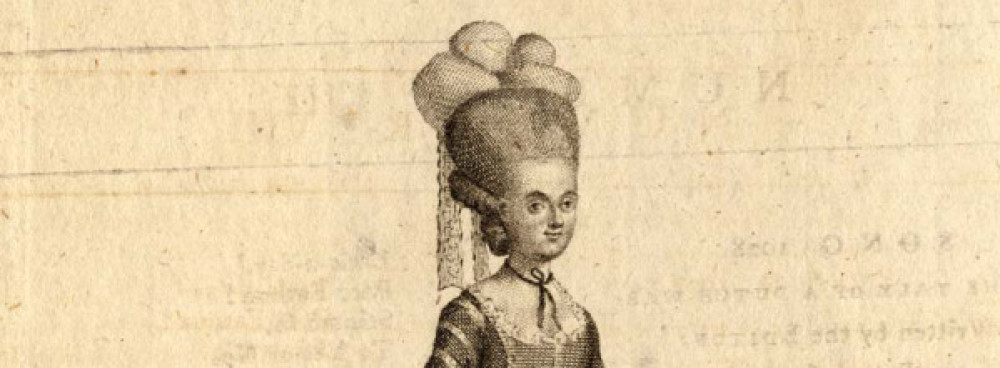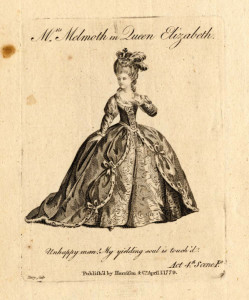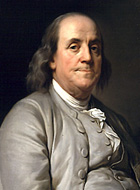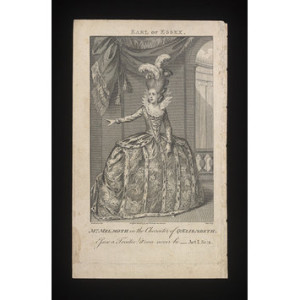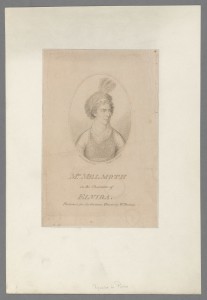Charlotte Melmoth, maiden name unknown, arrived in the United States in 1793 to join the Old American Company in New York. She had enjoyed a career on stages in England, Ireland and Scotland.
As a young actress in Great Britain, Charlotte traveled and performed with actor and author Courtney Melmoth (whose real name was Samuel Jackson Pratt), a man who probably was not her legal husband. According to Theatre in Belfast, Courtney Melmoth soon “recognized that his wife’s talent far exceeded his,” and as Charlotte became more popular, her partner ‘lived off his wife’s talents.’”[1]
Charlotte’s charms attracted the notice of Benjamin Franklin, who met her at some point in the 1770s, during her career in Great Britain. In 1778, Courtney Melmoth wrote to Dr. Franklin and included “a little Poem. . .the effort of Mrs. Melmoth’s Thoughts. . . .” Charlotte’s verse jokingly chastised Franklin for presenting his portrait to another lady instead of herself:
Gallantly, Franklin responded that he was “flatter’d exceedingly by Mrs. Melmoth’s showing the least Inclination for one of those Portraits…” He added “Her Quarrel on that Account is pleasing; the Reconciliation, when I can obtain it will be more so.”[2]Did you not, late, in open day,
Full liberal, give yourself away?
Did not the happy Laura bear the Prize?
Did not the Insult pass before my Eyes?
The Melmoths parted company at some point after 1781. Charlotte continued to perform in various theatre in Ireland, including Leoni’s Capel Street English Opera House, Smock Alley, Owenson’s, and Crow Street.[3] In February of 1793, “the excellent and much admired ACTRESS Mrs. Melmoth” arrived in the United States.[4]
Described by William Dunlap in his History of the American Theatre as “the best tragic actress the inhabitants of New York, then living, had ever seen,” she established a very successful second career in the United States, performing with the Old American Company in New York, and occasionally traveling with the company to Philadelphia and Boston.[5]
In the summer of 1795, Charlotte advertised to rent her house on Long Island:
Delightful Healthy Summer Retreat
To be let for the summer season, or longer if required, by Mrs. Melmoth (with the reservation of a couple rooms and the use of the kitchen for herself) her house on Long Island, consisting of two parlours, four bed chambers, a cellar, and a kitchen; also a coach house and stable, if wanted: there is a well of good water, and a new cistern. The house is situated about a mile and a half from Brooklyn ferry, on the road leading to Lequeen’s mills, and commands a delightful prospect of the city and harbour, and of the neighbouring country.[6]
In 1802, Charlotte Melmoth wrote a letter “To the Public” in the Commercial Advertiser of New York. She related “an unpleasant occurrence” that had transpired between herself and manager William Dunlap of the Park Theatre in New York. Her letter reported that she and Dunlap had quarreled about the proposed night of her Benefit performance. Melmoth accused Dunlap of trying to force her to take an undesirable night, and upon her refusal, proclaiming, “Then Madam … you shall never have another Benefit in this Theatre!” Melmoth ended her letter in the newspaper by noting that she had found another venue for her performance and would “take leave of a respectable company of my friends, the citizens of New-York, in a Farewell Address. . . . She signed herself “the public’s most obedient servant, Charlotte Melmoth.”[7]
In the Fall of 1802, Charlotte appeared with Sollee’s company in Charleston. Local newspapers reported, “Mrs Melmoth is a great acquisition. . .a voice commanding, yet female; action forcible, but modest, and flexibility of accent. . .”[8] At her benefit night in Charleston, Charlotte received $1000.00, a fact duly reported in Charleston and New York.[9] Despite her success in Charleston the actress returned to New York in 1803. She remained with the New York company until 1805, when Dunlap went bankrupt. Then, at the age of fifty six, Charlotte Melmoth began again with the Philadelphia troupe.[10]
At the Chestnut Street Theatre in Philadelphia, Melmoth appeared as Emelia opposite Anne Brunton Merry Wignell’s Desdemona in Othello on December 15, 1805 and as Queen Elizabeth in Mary Queen of Scots on January 15, 1806, opposite Mrs. Wignell in the title role. She depicted Gertrude in Hamlet in December of 1806, with James Fennell as Hamlet and Mrs. Wignell as Ophelia, but suffered several scathing reviews from a Philadelphia critic in The United States Gazette, who repeatedly called for the manager to engage Elizabeth Kemble Whitlock (sister of Sarah Siddons) for the roles of Gertrude and Lady Macbeth instead of “poor old Mrs. Melmoth.”[11] Despite these few unfavorable reviews, Charlotte Melmoth performed as a member of the Chestnut Street Theatre company until 1812.
The actress suffered an accident in the summer of 1812 when her carriage overturned on a trip from New York to Philadelphia. Although newspapers throughout the country carried notices of her death, she recovered from the injuries. However, she retired from the stage in August of 1812.[12]
Charlotte then kept a “school for elocution” on Washington Street. In addition, she owned property. A notice in the Charleston Courier of 1835 relates that “Mrs. Melmoth, the actress, bought a piece of land on Long Island, about thirty years ago, for $300, which sold a few weeks since for $64,000.”[13] Dunlap commented that she “prudently saved enough” and that she “occupied her latter years profitably.”[14]
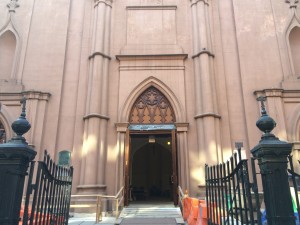
Photo from author’s collection.
Charlotte Melmoth died on September 28, 1823 at the age of seventy-four and was buried at Old St. Patrick’s Cathedral in New York. She has no grave marker, and records detailing the exact location of her grave have been lost.
NOTES
[1] John Greene, Theatre in Belfast. Bethlehem: Lehigh University Press, 2000, 247.
[2] “The Papers of Benjamin Franklin. The American Philosophical Society and Yale University. Digital Edition by The Packard Humanities Institute.
[3] Greene, 248.
[4][4] The Diary; or Loudon’s Register, 28 February 1793.
[5] William Dunlap, History of the American Theatre, New York: J & J. Harper 1832; reprint New York Burt Franklin, 1963, 203.
[6] New York Gazette, 3 July, 1805.
[7] Commercial Advertiser, 3 July 1802.
[8] Chronicle Express, 13 December 1802.
[9] Charleston City Gazette, 6 June 1803
[10] Gay Smith, Lady Macbeth in America, New York: Palgrave Macmillan, 2010, 90.
[11] The United States Gazette, 20 December 1806; 16 January 1807.
[12] Smith, 91.
[13] Charleston Courier, 6 May 1835.
[14] Dunlap, History, 202.
